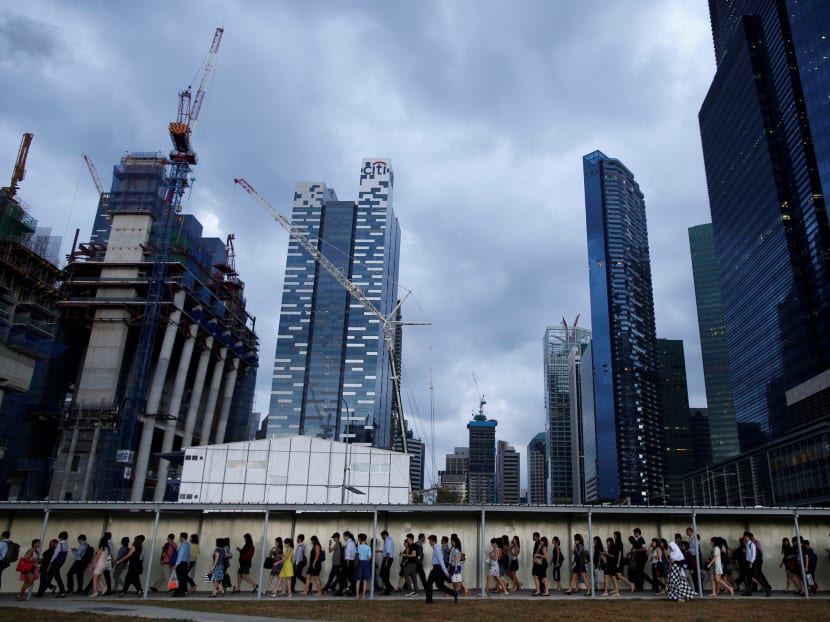Dip in layoffs, unemployment in first half of the year
SINGAPORE — For the first time in three years, the number of Singaporeans and permanent residents (PRs) in employment rose in the first half of this year, after contractions in the first six months of the last two years.

The labour market appears to be on the mend, with figures for the second quarter released by the Manpower Ministry (MOM) on Thursday (Sept 14) showing fewer layoffs and a dip in resident unemployment. Reuters file photo
SINGAPORE — For the first time in three years, the number of Singaporeans and permanent residents (PRs) in employment rose in the first half of this year, after contractions in the first six months of the last two years.
The growth in local employment was mainly in the community, social and personal services, financial and insurance services, and information and communication sectors, the Manpower Ministry (MOM) said.
Its labour market report for the second quarter of the year, released on Thursday (Sept 14), showed fewer layoffs and a dip in resident unemployment.
But the number of workers placed on short working-week or temporary layoff arrangements rose to its highest quarterly level in four years.
In the first six months of this year, local employment expanded by 4,000, following declines in the first half of last year (by 200) and 2015 (by 8,900). Economists, however, noted the figure was significantly lower than levels seen the earlier part of this decade.
In the first half of 2013, for instance, local employment grew by 34,100.
Between April and June this year, the number of workers laid off continued to decline, with 3,640 workers retrenched — the lowest in seven quarters.
In the first half of the year, 7,640 workers were retrenched, about 20 per cent fewer than in the same period last year.
Seasonally adjusted, the unemployment rate for citizens and permanent residents slid from 3.2 per cent to 3.1 per cent between March and June. Over the same period, the citizen unemployment rate also fell from 3.5 per cent to 3.3 per cent.
The MOM noted, however, that the rates — which were on an upward trajectory in previous quarters — are still higher than those recorded a year ago.
The seasonally adjusted resident long-term unemployment rate, which covers citizens and PRs jobless for 25 weeks or longer, decreased from 0.8 per cent to 0.7 per cent.
The total number of workers employed, excluding foreign domestic workers, shrank by 7,900 in the second quarter.
This was the second straight quarter of contractions in total employment, owing to “sustained declines in work-permit holders in construction and manufacturing”, the MOM said.
Meanwhile, the number of seasonally adjusted job openings rose from 46,800 to 49,000 between March and June. Due to this and a smaller pool of jobseekers, the job vacancies to jobseekers ratio also reached its highest since last September, with 85 openings for every 100 jobseekers in June.
CIMB Private Banking economist Song Seng Wun said the rise in local employment pointed to the first tentative signs of stability in the local labour market, buoyed by improvements in external demand and increased hiring in sectors like healthcare and infocomm technology (ICT).
Local employment is typically better in the second half of the year, when hiring gathers pace and factories gear up to meet festive demand, said Mr Song. He expects a stronger showing in the second half if the economy fares well for the year as a whole.
OCBC Bank’s treasury research and strategy head Selena Ling said local employment was a “beneficiary” of a shrinking foreign workforce.
Excluding foreign domestic workers, foreign employment shrank by 21,400 in the first six months of this year, after declining by 14,300 in the second half of last year.
The number of Employment Pass holders dipped by 2,400 for the first time since the first half of 2013, due mainly to falls in the professional services and infocomm sectors.
Despite fewer layoffs in the second quarter of 2017, 1,240 workers were placed on short work-week or temporary layoff arrangements — the highest since the second quarter of 2013 (1,670).
Mr Song said this reflected continued unevenness in the market, as some businesses try to tide over the slump without taking the “more drastic” step of retrenchments.
Credit Suisse economist Michael Wan said the pick-up in employment growth should continue into the first half of next year, with the ICT sector continuing to perform well.
Hiring could also gather speed in sectors like electronics.








